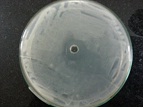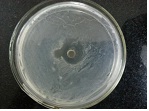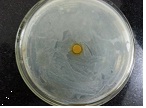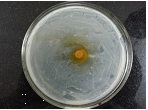The microorganisms in the oral cavity are most often the opportunistic pathogens. They have the ability to invade and establish an infectious process [1]. Longer the root canal remains infected, more the number of facultative anaerobes [2]. The elimination of microorganisms from the infected root canal defines the success of endodontic treatment.
High tissue toxicity, unpleasant smell and taste, allergic potential and inability to remove the smear layer are the disadvantages of NaOCl [4]. So, there is a need for agents that are both antibacterial and exert minimal tissue irritating effects [5]. Hence, the use of herbal irrigants is gaining interest.
The advantages of using herbal extracts are that they have few side effects, economical, better tolerated by patients and are renewable in nature. Herbal extracts such as triphala, curcuma longa, acacia nilotica, morinda citrifolia have active components like alkaloids, volatile essential oils, glycosides, resins, tannins, etc., which exert an antimicrobial, anti-inflammatory and antioxidant properties [6,7].
To the best of our knowledge, there is no study to comparatively evaluate the antimicrobial activity of turmeric, morinda citrifolia and 3% NaOCl against E. faecalis.
Hence, the present study intends to compare the antimicrobial properties of different herbal derivatives like turmeric and morinda citrifolia and chemical irrigants i.e., NaOCl against E. faecalis.
Materials and Methods
This in-vitro study was carried out in Wingene Biotech Research labs, Bengaluru, Karnataka, India.
Preparation of Microbial Inocula: A pure culture of E. faecalis (ATCC 21224) was grown on Mueller-Hinton agar, inoculated into nutrient broth, incubated at 37°C overnight and adjusted to an optical density of 0.5 with sterile nutrient broth.
Collection of Rhizomes: Fresh rhizomes of curcuma longa of analytical grade, grown organically without the use of any pesticides were collected from BSR-2, Erode, Tamil Nadu, India. The procedure for preparation of turmeric extracts (aqueous and hydro-alcoholic extracts) was followed according to the previous study done by Hegde MN et al., [8].
Morinda Citrifolia: Morinda citrifolia juice was used which was obtained from 18 Herbs, Organic Labs Pvt., Limited, Madurai, Tamil Nadu, India.
The antibacterial sensitivity test was performed by agar well diffusion method. The broth culture of E. faecalis was swabbed on sterile Mueller-Hinton agar plates using sterile swabs. Five wells of 8mm size named as groups 1, 2, 3, 4 and 5 respectively were made with sterile borer into agar plates containing the bacterial inoculums.
Each group consisted of 12 samples.
Group 1(50% Aqueous turmeric extract)
Group 2 (50% Hydro-alcoholic extract)
Group 3 (6% Morinda citrifolia juice)
Group 4 (3% NaOCl)
Group 5 (Distilled water)
100μl volume of each irrigant was dispensed into the wells of inoculated plates. Sterilized distilled water was used as a negative control. For proper diffusion of the irrigant, the agar plates were refrigerated for 60 minutes and incubated for 24 hours at 37°C. Microbial zones of inhibition were measured in millimetres. The mean and standard deviation of the diameter of inhibition zones were calculated.
Statistical analysis was performed by using One Way Analysis of Variance and compared by Post hoc Tukey test. The criteria for statistical significance was defined as p<0.05.
Results
[Table/Fig-1] shows the zone of inhibition of test solutions for E. faecalis. Maximum inhibition was observed by 3% NaOCl [Table/Fig-2] followed by morinda citrifolia [Table/Fig-3] compared with turmeric aqueous [Table/Fig-4] and hydroalcoholic extracts [Table/Fig-5]. There was a statistically significant difference between all the groups (p<0.05). [Table/Fig-6] shows the mean differences between various irrigants.
One way analysis of variance shows the zones of inhibition of test solutions for Enterococcus faecalis.
| Irrigant | N | Mean | SD | Median | Min. | Max. | ‘F’ value | ‘p’ value |
|---|
| Turmeric water extract | 12 | 8.50 | 0.522 | 8.50 | 8 | 9 | 2475.204 | <0.001 |
| Turmeric hydro-alcohol extract (70:30) | 12 | 14.42 | 0.515 | 14.00 | 14 | 15 |
| Morinda citrifolia | 12 | 20.25 | 0.622 | 20.00 | 19 | 21 |
| NaOCl (3%) | 12 | 27.33 | 0.492 | 27.00 | 27 | 28 |
Zone of inhibition with relation to NaOCl.

Zone of inhibition with relation to morinda citrifolia.

Zone of inhibition with relation to turmeric-aqueous extract.

Zone of inhibition with relation to turmeric hydroalcoholic extract.

Post hoc tukey test shows the mean differences between various irrigants.
| Comparison of mean differences between various irrigants | Mean Difference | ‘p’ value |
|---|
| Turmeric water extract | Turmeric Hydroalcohol Extract (70:30) | -5.917 | <0.001 |
| Morinda citrifolia | -11.750 | <0.001 |
| NaOCl (3%) | -18.833 | <0.001 |
| Turmeric hydroalcohol extract (70:30) | Morinda citrifolia | -5.833 | <0.001 |
| NaOCl (3%) | -12.917 | <0.001 |
| Morinda citrifolia | NaOCl (3%) | -7.083 | <0.001 |
Discussion
The final goal of root canal treatment is to clean the root canal system free of debris and microbiota thereby leading to well sealed microbial tight filling. This is achieved by ‘chemomechanical preparation’. The most commonly used chemical is NaOCl in varied concentrations. It is preferred over others for its unique ability to dissolve the pulp tissue and its antimicrobial efficacy [9–11].
But in-vivo, NaOCl has limited antimicrobial efficacy and this has led to problems in penetration to the most peripheral parts of the root-canal system.
Long-term exposure of dentin to high concentrations of NaOCl can have a detrimental effect on dentin elasticity and flexural strength, thereby predisposing the tooth to vertical fracture, which has a worse prognosis [4,12].
Due to the potential adverse effects and the safety concerns, herbal preparations have gained more popularity in the last few years.
Currently, anaerobic gram negative bacteria are isolated from endodontically infected teeth. But facultative bacteria like E. faecalis and aerobes like S. aureus are most commonly isolated from previously treated root canals.
In our in-vitro investigation for the newer antibacterial bioactive compounds, the unexplored folk medicinal plants like turmeric and morinda citrifolia were targeted against resistant microorganism like E. faecalis.
This study was conducted to compare herbal irrigants with NaOCl because it is the most widely used root canal irrigant.
In the present study, it was seen that both aqueous and hydro-alcoholic extracts of turmeric showed antimicrobial activity against E. faecalis, though it was not as significant as NaOCl group [Table/Fig-5,6]. This is in contrast with previous studies where the antibacterial efficacy of curcuma longa was similar to sodium hypochlorite [Table/Fig-7] [13].
Results from similar studies.
| Other similar studies | Mithra N Hegde et al., [8] | Turmeric aqueousTurmeric hydro-alcoholic | 9±1 mm---- |
| Other studies which are in contrast | Prasanna Neelakantan et al., [13] | Turmeric extract3% NaOCl | 32±4 mm34±5mm |
However, the antimicrobial properties of hydro-alcoholic extract were found to be better than the aqueous extract against the microorganism [Table/Fig-1,6]. The results in the present study were similar to the previous study stating that hydro-alcoholic extracts showed better antimicrobial properties than aqueous extracts [14].
The hydro-alcoholic extract of turmeric showed better zones of inhibition against E. faecalis [Table/Fig-1,6]. These results were in contrast to the study conducted by Hegde MN et al., where in it was found to have no zone of inhibition against E. faecalis [Table/Fig-7] [8].
The aqueous extract of turmeric showed mild activity against E. faecalis (8.5mm) [Table/Fig-1,6] and the results are in accordance with the study by Mithra N Hegde et al., [Table/Fig-7] and Niamsa N [8,15].
In the present study, antimicrobial efficacy of morinda citrifolia (20.25mm) was better than turmeric extracts, but second to NaOCl [Table/Fig-1,6]. The presence of acubin, L-asperuloside, alizarin and some other anthraquinone compounds may be responsible for the antibacterial property of morinda citrifolia.
Results of our study are in concurrence with the studies done by Balakrishnan et al., and Kandaswamy et al., who concluded that morinda citrifolia had significant antimicrobial effect against E. faecalis [16,17].
Distilled water was taken as a negative control group in our study as it has no effect on E. faecalis.
The major advantages of using herbal alternatives are easy availability, cost-effectiveness, increased shelf life, low toxicity, and lack of microbial resistance. Also, they are safer than synthetic alternatives, offering profound therapeutic benefits and more affordable treatment [14].
As the present study is an in-vitro experiment, other properties beyond the antimicrobial activity must also be investigated before these herbal irrigants are recommended for clinical use.
This was a preliminary study to evaluate the antimicrobial ability of these plant extracts against E. faecalis. The results indicated that these herbal alternatives have a potential for use in endodontics to control microflora of the root canal. In clinical situations like an open apex or in young permanent teeth, where NaOCl causes toxicity and hypersensitivity, these herbal irrigants can be potential alternatives [15].
As most of the studies which are carried out on herbal irrigants are in-vitro, further animal experimental studies are needed to determine their safety, toxicity and their efficacy.
Limitation
The agar diffusion test does not differentiate micro-biostatic and microbicidal properties of dental materials. It also does not provide any information regarding the viability of microorganisms after test. Hence, more studies are necessary to evaluate metabolic activities after longer periods.
Conclusion
Sodium hypochlorite, morinda citrifolia and turmeric failed to inhibit bacteria completely. But, considerable reduction in growth of E. faecalis was seen in the herbal extract groups though it was not as effective as NaOCl group. Considering the disadvantages of NaOCl which are documented in previous studies and physiological benefits of these herbal extracts, further studies can be carried out to consider them as an alternative for NaOCl at least in the failed root canals.
Within the limitations of the study, we can conclude that 3% NaOCl had the highest antibacterial effect on E. faecalis, and among the herbal irrigants, morinda citrifolia showed good antibacterial activity, followed by turmeric hydro-alcoholic extract and turmeric water extract.